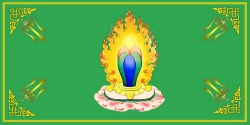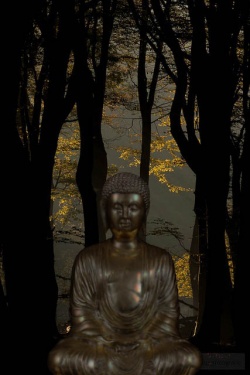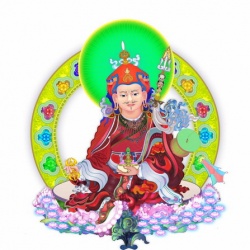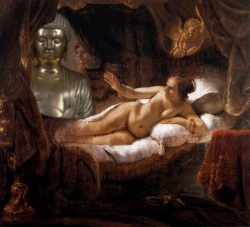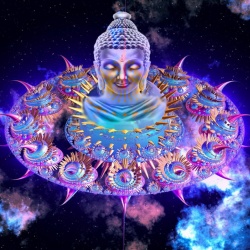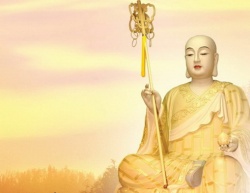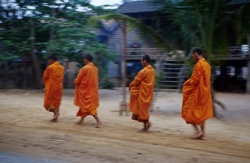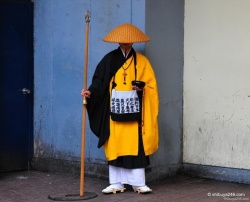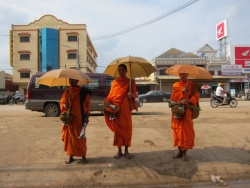Difference between revisions of "Vaishnava Pancarātra"
(Created page with " '''Pāñcarātra''' are Vaishnava Sanskrit Agamic texts.<ref name="GOS">Oriental Institute, Maharaja Sayajirao {{Wiki|University}...") |
m (Text replacement - "Texts" to "Texts") |
||
| (3 intermediate revisions by the same user not shown) | |||
| Line 1: | Line 1: | ||
| + | <nomobile>{{DisplayImages|1519|4029|4224|256|3811|1353|3634|1043|2238|1206|1085|2168}}</nomobile> | ||
| Line 6: | Line 7: | ||
| + | '''[[Pāñcarātra]]''' are [[Vaishnava]] [[Sanskrit]] [[Āgama (Hinduism)|Agamic]] texts. [[Oriental Institute]], [[Maharaja]] [[Sayajirao]] {{Wiki|University}} of Baroda (1940). Gaekwad {{Wiki|Oriental}} Series, Issue 86, p.7. | ||
| − | + | Literally meaning ''five nights'' (''[[pañca]]'': five, ''[[rātra]]'': nights),Jones, Constance and Ryan, James D. (2007). | |
| − | {{Wiki|Encyclopedia}} of [[Hinduism]], p.321-322. Infobase Publishing. ISBN 0816075646 | + | {{Wiki|Encyclopedia}} of [[Hinduism]], p.321-322. Infobase Publishing. ISBN 0816075646 the term ''{{Wiki|Pancharatra}}'' has been variously interpreted. |
| − | The term has also been attributed to the [[Shatapatha Brahmana]] 12.6 wherein [[Narayana]] performed a [[Wikipedia:sacrifice|sacrifice]] for five nights and became a [[transcendent]] and immanent being. | + | The term has also been attributed to the [[Shatapatha Brahmana]] 12.6 wherein [[Narayana]] performed a [[Wikipedia:sacrifice|sacrifice]] for five nights and became a [[transcendent]] and immanent being.[[Sharma]], C. D. (1991). |
| − | Critical Survey Of [[Indian Philosophy]], p.336. {{Wiki|Motilal Banarsidass}} Publications. ISBN 8120803655 | + | Critical Survey Of [[Indian Philosophy]], p.336. {{Wiki|Motilal Banarsidass}} Publications. ISBN 8120803655 |
| − | The {{Wiki|Pancharatra}} [[Agamas]] constitute the most important texts of the [[Srivaishnava]] [[Sampradaya]] of [[Ramanuja]]. | + | The {{Wiki|Pancharatra}} [[Agamas]] constitute the most important texts of the [[Srivaishnava]] [[Sampradaya]] of [[Ramanuja]]. The {{Wiki|Pancharatra}} [[Agamas]] are composed of more than 200 texts; [[Datta]], Amaresh (1987). |
| − | Encyclopaedia of [[Indian]] {{Wiki|Literature}}: A-Devo, p.95. Sahitya Akademi. ISBN 8126018038 | + | Encyclopaedia of [[Indian]] {{Wiki|Literature}}: A-Devo, p.95. Sahitya Akademi. ISBN 8126018038 with various suggested time periods of composition; [[including]] the 3rd century BC, Prakash, Om (2005). {{Wiki|Cultural}} History Of [[India]], p.120. [[New Age]] International. ISBN 8122415873</ref> and a period between 600 AD to 850 AD. |
| Line 23: | Line 25: | ||
| − | [[Vishnu]] worshipers of today, represented in a wide spectrum of [[traditions]], generally follow the system of {{Wiki|Pancharatra}} {{Wiki|worship}}. The {{Wiki|concept}} of Naḍa and Naḍa-Brahman appear already in [[Sāttvata | + | [[Vishnu]] worshipers of today, represented in a wide spectrum of [[traditions]], generally follow the system of {{Wiki|Pancharatra}} {{Wiki|worship}}. |
| + | |||
| + | The {{Wiki|concept}} of [[Naḍa]] and [[Naḍa-Brahman]] appear already in [[Sāttvata Samhita]] or [[Sāttvata Tantra]] and in [[Jayākhya Samhita]], two texts considered most [[Wikipedia:canonical|canonical]] of {{Wiki|Pancharatra}} texts. | ||
| Line 30: | Line 34: | ||
| − | + | dvapariyair janair viṣṇuḥ pancarātrais ca kevalam | |
| − | kalau tu nāma-mātreṇa pujyate [[bhagavan]] hariḥ | + | kalau tu nāma-mātreṇa pujyate [[bhagavan]] hariḥ |
| − | "In [[Dvāpara-yuga]], [[Vishnu]] is exclusively | + | "In [[Dvāpara-yuga]], [[Vishnu]] is exclusively worshiped according to the {{Wiki|principles}} of the {{Wiki|Pancharatra}} [[Scripture]], but in this age of [[Kali-yuga]], the [[Supreme Lord Hari]] is worshiped only by the [[chanting]] of his {{Wiki|Holy}} [[Name]]." |
[[Jiva Gosvami]] had stated in his ''[[Paramātma Sandārbha]]'', forming part of [[six principal Sandārbhas]], or [[philosophical]] treateses of [[Gaudiya Vaishnavism]], that, | [[Jiva Gosvami]] had stated in his ''[[Paramātma Sandārbha]]'', forming part of [[six principal Sandārbhas]], or [[philosophical]] treateses of [[Gaudiya Vaishnavism]], that, | ||
| − | "[[Seeing]] that the imperfect [[scriptures]] in the modes of [[passion]] and [[ignorance]] bring only a host of troubles, and also [[seeing]] that the original [[Vedas]] are very difficult to follow properly, and thus being very dissatisfied with both of these, the all-knowing [[scripture]] authors affirm the {{Wiki|superiority}} of the Pancharatras, which describe the [[pure]] [[absolute truth]], [[Narayana]], and the {{Wiki|worship}} of the Lord, which is very easy to perform." | + | "[[Seeing]] that the imperfect [[scriptures]] in the modes of [[passion]] and [[ignorance]] bring only a host of troubles, and also [[seeing]] that the original [[Vedas]] are very difficult to follow properly, and thus being very dissatisfied with both of these, the all-knowing [[scripture]] authors affirm the {{Wiki|superiority}} of the [[Pancharatras]], which describe the [[pure]] [[absolute truth]], [[Narayana]], and the {{Wiki|worship}} of the Lord, which is very easy to perform." |
| − | ''[[Paramātma Sandārbha]]'', [[Annucheda]] 17.</ref> In the same [[Sandārbha]] [[Jiva Gosvami]] states | + | ''[[Paramātma Sandārbha]]'', [[Annucheda]] 17.</ref> In the same [[Sandārbha]] [[Jiva Gosvami]] states pañcarātrasya kṛtsnasya vaktā tu [[bhagavān]] svayam</ref> that [[god]] himself, [[Svayam Bhagavan]], had spoken the [[Narada Pancharatra]], which is accepted as a [[pramāṇa]] by [[Gaudiya]] [[scholars]]. |
| Line 56: | Line 60: | ||
<poem> | <poem> | ||
| − | Para, | + | [[Para]], |
[[Vyuha]], | [[Vyuha]], | ||
[[Vibhava]], | [[Vibhava]], | ||
[[Antaryamin]], and | [[Antaryamin]], and | ||
| − | Archa. | + | [[Archa]]. |
</poem> | </poem> | ||
[[Living beings]] can interact with the [[divine]] through one or another of these five. | [[Living beings]] can interact with the [[divine]] through one or another of these five. | ||
| − | '''Para [[Manifestation]]''' | + | '''[[Para]] [[Manifestation]]''' [[Bhatt]], Dr. S.R. ''The [[Philosophy]] of the {{Wiki|Pancharatra}}'', page 38-41 |
The Para [[form]] is sometimes described as the first immanent [[manifestation]] of the [[Supreme Being]]. | The Para [[form]] is sometimes described as the first immanent [[manifestation]] of the [[Supreme Being]]. | ||
| Line 72: | Line 76: | ||
| − | [[Vasudeva]], characterized by the [[six gunas]], is sometimes called the first Vyuha. From [[Vasudeva]] [[emanates]] [[Lakshmana|Sankarshana]] in whom [[jnana]] and [[bala]] alone get [[manifested]]. From [[Sankarshana]] comes [[Bharata (Ramayana)|Pradyumna]] to whom belong [[aishvarya]] and [[virya]]. From {{Wiki|Pradyumna}} [[emanates]] [[Shatrughna|Aniruddha]] to whom [[shakti]] and [[tejas]] appertain. | + | [[Vasudeva]], characterized by the [[six gunas]], is sometimes called the first Vyuha. From [[Vasudeva]] [[emanates]] [[Lakshmana|Sankarshana]] in whom [[jnana]] and [[bala]] alone get [[manifested]]. |
| + | |||
| + | From [[Sankarshana]] comes [[Bharata (Ramayana)|Pradyumna]] to whom belong [[aishvarya]] and [[virya]]. From {{Wiki|Pradyumna}} [[emanates]] [[Shatrughna|Aniruddha]] to whom [[shakti]] and [[tejas]] appertain. | ||
| + | |||
| + | As we have seen, the {{Wiki|Pancharatra}} thinkers were very much particular in safeguarding and preserving the [[purity]] and unchanged [[nature]] of the [[transcendent]] [[Supreme Being]]. | ||
| − | + | From that point of view, the chief [[merit]], and hence its primary significance, is that it is such a process of [[emanation]] in which the [[Supreme Being]] remains unaffected and unchanged in all the five-fold [[manifestations]]. | |
| Line 83: | Line 91: | ||
| − | Closely connected with the [[doctrine]] of vyuhas, is the next [[manifestation]] of [[God]], named as [[vibhava]] ([[manifestation]]) or [[avatar]] (descent). The only [[supreme being]] the {{Wiki|Pancharatra}} [[philosophers]] knew about was the [[Transcendent]] One, who was not in any way directly related to the [[world]]. Therefore, the [[Samhitas]] explicitly describe the [[avataras]] as either all springing from [[Aniruddha]], or some from [[Vasudeva]] and the rest from the other three vyuhas. One should not be mistaken here in assuming that the [[Supreme Being]] himself takes [[avatara]]. This is a {{Wiki|puranic}} {{Wiki|conception}}. The {{Wiki|Pancharatra}} [[Samhitas]] nowhere maintain that the [[Supreme Being]], laying aside its [[transcendent]], unmoving [[nature]] assumes these finite [[forms]]. This is impermissible by the premises of the system. The [[Supreme Being]] is merely a spectator with an [[attitude]] of passivity and [[indifference]]. It cherishes no [[attachment]] to the [[mundane world]], and it is beyond its [[nature]] to do so. | + | Closely connected with the [[doctrine]] of vyuhas, is the next [[manifestation]] of [[God]], named as [[vibhava]] ([[manifestation]]) or [[avatar]] (descent). |
| + | |||
| + | The only [[supreme being]] the {{Wiki|Pancharatra}} [[philosophers]] knew about was the [[Transcendent]] One, who was not in any way directly related to the [[world]]. | ||
| + | |||
| + | Therefore, the [[Samhitas]] explicitly describe the [[avataras]] as either all springing from [[Aniruddha]], or some from [[Vasudeva]] and the rest from the other three vyuhas. | ||
| + | |||
| + | One should not be mistaken here in assuming that the [[Supreme Being]] himself takes [[avatara]]. This is a {{Wiki|puranic}} {{Wiki|conception}}. | ||
| + | |||
| + | The {{Wiki|Pancharatra}} [[Samhitas]] nowhere maintain that the [[Supreme Being]], laying aside its [[transcendent]], unmoving [[nature]] assumes these finite [[forms]]. This is impermissible by the premises of the system. | ||
| + | |||
| + | The [[Supreme Being]] is merely a spectator with an [[attitude]] of passivity and [[indifference]]. | ||
| + | |||
| + | It cherishes no [[attachment]] to the [[mundane world]], and it is beyond its [[nature]] to do so. | ||
| Line 91: | Line 111: | ||
| − | The fourth [[manifestation]] is the [[Antaryamin]] [[avatara]], which is [[Aniruddha]] as the ‘Inner [[Ruler]]’ of all [[souls]]. It is a mysterious power seated in the ‘[[lotus]] of the [[heart]]’. Here again it should be noted that this is not a [[manifestation]] of the [[Supreme Being]], but only of [[Aniruddha]], one of the vyuhas. | + | The fourth [[manifestation]] is the [[Antaryamin]] [[avatara]], which is [[Aniruddha]] as the ‘Inner [[Ruler]]’ of all [[souls]]. |
| + | |||
| + | It is a mysterious power seated in the ‘[[lotus]] of the [[heart]]’. | ||
| + | |||
| + | Here again it should be noted that this is not a [[manifestation]] of the [[Supreme Being]], but only of [[Aniruddha]], one of the vyuhas. | ||
| − | |||
| − | The {{Wiki|Pancharatra}} [[Samhitas]], unlike [[Mahābhārata|Narayaniya]], finally [[recognize]] the archa [[manifestation]] of [[God]]. An [[inanimate]] [[object]] (i.e. image of [[Vishnu]]), if duly [[consecrated]] according to the {{Wiki|Pancharatra}} [[rites]], acquires a [[miraculous power]], and the [[Shakti]] of [[Vishnu]] descends into it. It is meant for the {{Wiki|purpose}} of daily {{Wiki|worship}}. | + | ==[[Archa Manifestation]]'== |
| − | This archa {{Wiki|worship}} is different from the [[pratima]] {{Wiki|worship}}. In the [[latter]] the [[symbol]] is the locus, on which the [[devotee]] [[concentrates]] his [[thought]]. But no sooner the [[thought]] is centralized, than the locus soon gets out of his [[vision]] and no necessity thereof is felt. But in the archa {{Wiki|worship}}, on the other hand, the [[devotee]] [[feels]] the very presence of [[God]] in it. And as such the [[inanimate]] image soon acquires a new meaning, becomes the [[object]] of [[love]], of heart’s hankering and of the eye’s rest. This we find in the [[religion]] of the [[alvars]] as well, who are the [[Tamil]] [[Vaishnava]] [[saints]]. | + | |
| + | |||
| + | The {{Wiki|Pancharatra}} [[Samhitas]], unlike [[Mahābhārata|Narayaniya]], finally [[recognize]] the archa [[manifestation]] of [[God]]. | ||
| + | |||
| + | An [[inanimate]] [[object]] (i.e. image of [[Vishnu]]), if duly [[consecrated]] according to the {{Wiki|Pancharatra}} [[rites]], acquires a [[miraculous power]], and the [[Shakti]] of [[Vishnu]] descends into it. | ||
| + | |||
| + | It is meant for the {{Wiki|purpose}} of daily {{Wiki|worship}}. | ||
| + | This archa {{Wiki|worship}} is different from the [[pratima]] {{Wiki|worship}}. In the [[latter]] the [[symbol]] is the locus, on which the [[devotee]] [[concentrates]] his [[thought]]. | ||
| + | |||
| + | But no sooner the [[thought]] is centralized, than the locus soon gets out of his [[vision]] and no necessity thereof is felt. But in the archa {{Wiki|worship}}, on the other hand, the [[devotee]] [[feels]] the very presence of [[God]] in it. | ||
| + | |||
| + | And as such the [[inanimate]] image soon acquires a new meaning, becomes the [[object]] of [[love]], of heart’s hankering and of the eye’s rest. This we find in the [[religion]] of the [[alvars]] as well, who are the [[Tamil]] [[Vaishnava]] [[saints]]. | ||
| Line 111: | Line 145: | ||
| − | Surrender to [[god]] is one of the core teachings of {{Wiki|Pancharatra}}. The six aspects are explained below in brief: | + | Surrender to [[god]] is one of the core teachings of {{Wiki|Pancharatra}}. |
| + | |||
| + | The six aspects are explained below in brief: | ||
| − | [[Atma-nikshepa]] or '''[[nyAsa]]''' - placing oneself completely and directly under [[God's]] care | + | [[Atma-nikshepa]] or '''[[nyAsa]]''' - placing oneself completely and directly under [[God's]] care. |
| − | + | This involves giving up {{Wiki|independent}} ownership in matters of [[actions]] or {{Wiki|fruits}} thereof. | |
| − | + | This in fact is the real [[Saranagati]]. | |
| − | We all know the enormous [[feeling]] of Karpanya that our Azhvars have expressed through their compositions. | + | The subsequent five are to be regarding as assisting this. |
| + | |||
| + | The [[obstacle]] to [[nyasa]] is [[phalepsa]] or the [[desire]] for [[mundane]] benefits,which should therefore be avoided. | ||
| + | |||
| + | '''ii) [[Karpanya]]''' - This refers to [[absolute]] [[humility]] bordering on lowliness and honest [[awareness]] of one's [[own]] natural [[ignorance]], [[impurity]] etc., partly because of stains acquired through countless [[births]]. | ||
| + | |||
| + | We all know the enormous [[feeling]] of [[Karpanya]] that our [[Azhvars]] have expressed through their compositions. | ||
This leads to ridding the [[arrogance]] that one may have because of parentage, {{Wiki|learning}}, [[wealth]], etc., and to get the [[sense]] that without the aid of Godhead, whatever we undertake on our [[own]] is [[bound]] to fail. | This leads to ridding the [[arrogance]] that one may have because of parentage, {{Wiki|learning}}, [[wealth]], etc., and to get the [[sense]] that without the aid of Godhead, whatever we undertake on our [[own]] is [[bound]] to fail. | ||
| Line 126: | Line 168: | ||
| − | '''iii) [[Maha-Visvasa]]''' - irrepressible and great [[faith]] in Godhead. Involves the [[understanding]] that [[God]] is the benefactor of all [[beings]], and His [[compassion]] is always and readily available. The firm conviction that He will not fail to {{Wiki|protect}} us is 'Visvasa'. This by itself is capable of eradicating all [[sins]]. | + | '''iii) [[Maha-Visvasa]]''' - irrepressible and great [[faith]] in Godhead. |
| + | |||
| + | Involves the [[understanding]] that [[God]] is the benefactor of all [[beings]], and His [[compassion]] is always and readily available. | ||
| + | |||
| + | The firm conviction that He will not fail to {{Wiki|protect}} us is 'Visvasa'. | ||
| + | |||
| + | This by itself is capable of eradicating all [[sins]]. | ||
| + | |||
| + | '''iv) [[goptr]]''' - The deliberate choice of [[Bhagavan]] [[Sriman Narayana]] as the sole [[Protector]]. | ||
| − | + | Even when it is granted that anyway He is the sole [[protector]], [[Lakshmi-tantra]] points out that what is involved in this [[a'nga]] is the [[conscious]] and [[mindful]] selection of Him, the [[acknowledgment]] that we need [[protection]], and that He and only He can {{Wiki|protect}} us. | |
'''v) [[pratikulya-vivarjana]]''' - giving up whatever is [[antagonistic]] to any of His creations or to Him. A [[devotee]] must realize that all [[beings]] are like himself. | '''v) [[pratikulya-vivarjana]]''' - giving up whatever is [[antagonistic]] to any of His creations or to Him. A [[devotee]] must realize that all [[beings]] are like himself. | ||
| − | '''vi) [[anukulya-niscaya]]''' - The resolve to do good to all [[beings]]. The [[realization]] that all [[beings]] are in [[actuality]] the [[body]] of [[God]], and the resolve to live in accordance with the will of [[God]]. Ahirbudhnya [[samhita]] gives a beautiful illustration of [[Saranagati]] using a passenger who wants to cross a [[river]] in a boat. | + | '''vi) [[anukulya-niscaya]]''' - The resolve to do good to all [[beings]]. |
| + | |||
| + | The [[realization]] that all [[beings]] are in [[actuality]] the [[body]] of [[God]], and the resolve to live in accordance with the will of [[God]]. | ||
| + | |||
| + | Ahirbudhnya [[samhita]] gives a beautiful illustration of [[Saranagati]] using a passenger who wants to cross a [[river]] in a boat. | ||
It is the passenger's {{Wiki|responsibility}} to go and sit in the boat, and that is the end of his {{Wiki|responsibility}}; the job or rowing the boat is not his, but that of the boatman (in this case [[God]] Himself). | It is the passenger's {{Wiki|responsibility}} to go and sit in the boat, and that is the end of his {{Wiki|responsibility}}; the job or rowing the boat is not his, but that of the boatman (in this case [[God]] Himself). | ||
| − | Six aspects of surrender are described in many [[Pancaratra]] [[samhitas]] such as Ahirbudhnya [[Samhita]], [[Lakshmi]] [[Tantra]] etc., [[thought]] the order of importance may vary. [[Lakshmi]] [[Tantra]] give the following: | + | Six aspects of surrender are described in many [[Pancaratra]] [[samhitas]] such as Ahirbudhnya [[Samhita]], [[Lakshmi]] [[Tantra]] etc., [[thought]] the order of importance may vary. [[Lakshmi]] [[Tantra]] give the following: |
| − | |||
| + | <poem> | ||
"''Anukulyasya samkalpah pratikulyasya varjanam'' |<br /> | "''Anukulyasya samkalpah pratikulyasya varjanam'' |<br /> | ||
''rakshishyatiti visvaso goptrtva varanam [[tatha]] '' ||<br /> | ''rakshishyatiti visvaso goptrtva varanam [[tatha]] '' ||<br /> | ||
''[[atma]] nikshepa karpanye shadvidha saranagatih '' || ([[Lakshmi]] [[Tantra]] 17, 59-61) | ''[[atma]] nikshepa karpanye shadvidha saranagatih '' || ([[Lakshmi]] [[Tantra]] 17, 59-61) | ||
| − | </ | + | </poem> |
| − | Thus the order of the limbs given in [[Lakshmi]] [[Tantra]] is: Anukūlya Samkalpam, Prātikūlya Varjanam, {{IAST|Mahā Viṣvāsam}}, {{IAST|Goptṛtva VaraNam}}, [[Atma]] Nikshepam, and kArpaNyam. In Ahribudhnya [[Samhitā]], the order given is: [[Atma]] Nikshepam or Nyāsam, Kārpanyam, {{IAST|Mahā Viṣvāsam}}, {{IAST|Goptṛtvam}}, Prātikūlya Varjanam, and Anukūlya Sampakpam. {{IAST|Svāmi Deṣikan}} has addressed these confusions in his Nyāsa VimSati (Slokam 12), and concludes that those who know Prapatti Sāstra well agree that there are five anga-s to Prapatti, and the different positions taken in [[respect]] of the number and sequence of importance etc. of the aspects of Prapatti really say the same thing in the end (sarva [[vākya]] eka kaNThyam). | + | Thus the order of the limbs given in [[Lakshmi]] [[Tantra]] is: Anukūlya Samkalpam, Prātikūlya Varjanam, {{IAST|Mahā Viṣvāsam}}, {{IAST|Goptṛtva VaraNam}}, [[Atma]] Nikshepam, and kArpaNyam. In Ahribudhnya [[Samhitā]], the order given is: [[Atma]] Nikshepam or Nyāsam, Kārpanyam, {{IAST|Mahā Viṣvāsam}}, {{IAST|Goptṛtvam}}, Prātikūlya Varjanam, and Anukūlya Sampakpam. |
| + | |||
| + | {{IAST|Svāmi Deṣikan}} has addressed these confusions in his Nyāsa VimSati (Slokam 12), and concludes that those who know Prapatti Sāstra well agree that there are five anga-s to Prapatti, and the different positions taken in [[respect]] of the number and sequence of importance etc. of the aspects of Prapatti really say the same thing in the end (sarva [[vākya]] eka kaNThyam). | ||
| + | |||
| + | [[Atma]] Nikshepam or nyāsam is considered the main ingredient of Prapatti - the conviction that one's [[own]] [[effort]] in [[attaining]] Him will not bear fruit, and placing oneself directly under His care and giving up ownership of one's [[own]] [[protection]] or the benefits from any [[actions]] to Him. | ||
| + | |||
| + | The other five are then the limbs for Nyāsa, that are of {{Wiki|equal}} importance as conveyed to us by {{IAST|Svāmi Deṣikan}}. Thus, for performing surrender or [[Atma]] Nikshepa or Nyāsam, one needs [[absolute]] [[humility]] (Kārpanyam), Anukūlya Samkaplam, Prātikūlya Varjanam, etc. | ||
| − | |||
== [[Moksha]] == | == [[Moksha]] == | ||
| + | |||
| + | |||
The [[attainment]] of the glorious and supreme feet of [[Vishnu]] (''{{IAST|tad viṣṇoh paramam padam}}''). {{Wiki|Pancharatra}} texts were written before the [[philosophies]] of [[advaita]] and visishtadvaita were established and vary in regards to the [[nature]] of the [[soul]] after [[liberation]]. In general, the [[soul]] is seen as a portion of Laksmi ([[goddess]]) and remains forever next to [[Narayana]] ([[god]]), [[liberation]] is therefore returning to the One. | The [[attainment]] of the glorious and supreme feet of [[Vishnu]] (''{{IAST|tad viṣṇoh paramam padam}}''). {{Wiki|Pancharatra}} texts were written before the [[philosophies]] of [[advaita]] and visishtadvaita were established and vary in regards to the [[nature]] of the [[soul]] after [[liberation]]. In general, the [[soul]] is seen as a portion of Laksmi ([[goddess]]) and remains forever next to [[Narayana]] ([[god]]), [[liberation]] is therefore returning to the One. | ||
Based on the [[Purusha Sukta]] ({{Wiki|Rigveda}} 10.90) the {{Wiki|Pancharatra}} [[Agamas]] teach that [[God]] ([[Narayana]] or [[Vasudeva]]) [[manifests]] the whole [[world]] from one fourth of himself. Therefore three parts of the supreme are [[immortal]] [[nectar]] that can be [[attained]] by {{Wiki|liberated}} [[beings]]. {{Wiki|Modern}} {{Wiki|Vaisnavism}} evolved from the {{Wiki|Pancharatra}} and its theories. | Based on the [[Purusha Sukta]] ({{Wiki|Rigveda}} 10.90) the {{Wiki|Pancharatra}} [[Agamas]] teach that [[God]] ([[Narayana]] or [[Vasudeva]]) [[manifests]] the whole [[world]] from one fourth of himself. Therefore three parts of the supreme are [[immortal]] [[nectar]] that can be [[attained]] by {{Wiki|liberated}} [[beings]]. {{Wiki|Modern}} {{Wiki|Vaisnavism}} evolved from the {{Wiki|Pancharatra}} and its theories. | ||
| − | == {{Wiki|Pancharatra}} | + | |
| − | The {{Wiki|Pancharatra}} texts are [[samhitas]] and [[tantras]] which both classify as [[Agama]] due to [[subject]] {{Wiki|matter}}. The [[Agamas]] are predominantly divided into {{Wiki|Saiva}}, Sakta and [[Vaishnava]] [[Agamas]]. The [[Vaishnava]] [[Agamas]] identify [[Brahman]] as [[Vasudeva]]. The [[Mahabharata]] subscribes to the {{Wiki|Pancharatra}} [[philosophy]] in its Narayaniya section. The [[Vaishnava]] [[Agamas]] are: {{Wiki|Pancharatra}} [[Agama]] and [[Vaikhanasa]] [[Agama]]. Some of the Samhita's are: | + | == {{Wiki|Pancharatra}} Texts == |
| + | |||
| + | |||
| + | The {{Wiki|Pancharatra}} texts are [[samhitas]] and [[tantras]] which both classify as [[Agama]] due to [[subject]] {{Wiki|matter}}. The [[Agamas]] are predominantly divided into {{Wiki|Saiva}}, [[Sakta]] and [[Vaishnava]] [[Agamas]]. | ||
| + | |||
| + | The [[Vaishnava]] [[Agamas]] identify [[Brahman]] as [[Vasudeva]]. | ||
| + | |||
| + | The [[Mahabharata]] subscribes to the {{Wiki|Pancharatra}} [[philosophy]] in its [[Narayaniya]] section. | ||
| + | |||
| + | The [[Vaishnava]] [[Agamas]] are: {{Wiki|Pancharatra}} [[Agama]] and [[Vaikhanasa]] [[Agama]]. | ||
| + | |||
| + | |||
| + | Some of the [[Samhita's]] are: | ||
| + | |||
| + | <poem> | ||
* [[Agastya-Samhita]] | * [[Agastya-Samhita]] | ||
* [[Aniruddha-Samhita]] | * [[Aniruddha-Samhita]] | ||
| Line 199: | Line 274: | ||
* [[Hayasirsa-Samhita]] | * [[Hayasirsa-Samhita]] | ||
| + | </poem> | ||
This list is mainly based on the list of the [[Sanskrit]] texts from the H. Daniel Smith [[Agama]] Collection, Cleveland, Ohio. | This list is mainly based on the list of the [[Sanskrit]] texts from the H. Daniel Smith [[Agama]] Collection, Cleveland, Ohio. | ||
| Line 213: | Line 289: | ||
[[Gaudiya Vaishnavism|Gaudiya Vaishnava]]s follow [[Brahma Samhita]] and '''"Naradiya [[Samhita]]"'''. | [[Gaudiya Vaishnavism|Gaudiya Vaishnava]]s follow [[Brahma Samhita]] and '''"Naradiya [[Samhita]]"'''. | ||
| + | |||
| + | |||
=== {{Wiki|Literature}} === | === {{Wiki|Literature}} === | ||
| + | |||
| + | |||
* Aiyangar, [[Pandit]] M. Duraiswami, and Venugopalacharya, [[Pandit]] T. Sri Pancaratraraksa of Sri [[Vedanta Desika]]. The [[Adyar]] Library and Research Centre, [[Madras]], [[India]], 1996. | * Aiyangar, [[Pandit]] M. Duraiswami, and Venugopalacharya, [[Pandit]] T. Sri Pancaratraraksa of Sri [[Vedanta Desika]]. The [[Adyar]] Library and Research Centre, [[Madras]], [[India]], 1996. | ||
| + | |||
* Apte, Dr. P. P. (edited). Pauskara [[Samhita]]. Rashtriya [[Sanskrit]] Vidyapeetha, [[Tirupati]] Series No.54, [[Tirupati]], [[India]], 1991. | * Apte, Dr. P. P. (edited). Pauskara [[Samhita]]. Rashtriya [[Sanskrit]] Vidyapeetha, [[Tirupati]] Series No.54, [[Tirupati]], [[India]], 1991. | ||
*[[Bhatt]], Dr. S.R. The [[Philosophy]] of the {{Wiki|Pancharatra}}. [[Ganesh]] and Company, [[Madras]], [[India]], 1968 | *[[Bhatt]], Dr. S.R. The [[Philosophy]] of the {{Wiki|Pancharatra}}. [[Ganesh]] and Company, [[Madras]], [[India]], 1968 | ||
| + | |||
* [[Gupta]], Sanjukta. Laksmi [[Tantra]], A [[Pancaratra]] Text. E.J.Brill, Leiden {{Wiki|Netherlands}} 1972, reprint {{Wiki|Motilal Banarsidass}} Publishers, {{Wiki|Delhi}}, 2003. | * [[Gupta]], Sanjukta. Laksmi [[Tantra]], A [[Pancaratra]] Text. E.J.Brill, Leiden {{Wiki|Netherlands}} 1972, reprint {{Wiki|Motilal Banarsidass}} Publishers, {{Wiki|Delhi}}, 2003. | ||
| + | |||
* [[Krishnamacharya]], [[Pandit]] V. (edited). Ahirbudhnya-Samhita of the Päncaräträgama (vol I and II). The [[Adyar]] Library and Research Centre, [[Madras]], [[India]], 1986. | * [[Krishnamacharya]], [[Pandit]] V. (edited). Ahirbudhnya-Samhita of the Päncaräträgama (vol I and II). The [[Adyar]] Library and Research Centre, [[Madras]], [[India]], 1986. | ||
| + | |||
* Matsubara, Mitsunori, ''[[Pancaratra]] [[Samhitas]] and Early Vaisnava {{Wiki|Theology}}'', {{Wiki|Motilal Banarsidass}}, {{Wiki|New Delhi}}, 1994. | * Matsubara, Mitsunori, ''[[Pancaratra]] [[Samhitas]] and Early Vaisnava {{Wiki|Theology}}'', {{Wiki|Motilal Banarsidass}}, {{Wiki|New Delhi}}, 1994. | ||
| + | |||
* ---, ''[[Monotheistic]] {{Wiki|Theory}} of the early [[Vaisnavas]], Vyuha {{Wiki|Theory}} in the Early [[Pancaratra]]'', 1990. | * ---, ''[[Monotheistic]] {{Wiki|Theory}} of the early [[Vaisnavas]], Vyuha {{Wiki|Theory}} in the Early [[Pancaratra]]'', 1990. | ||
| + | |||
* ---, ''The Formation of the Pancaratra's {{Wiki|Theory}} of the Four [[Vyuhas]]'', 1991. | * ---, ''The Formation of the Pancaratra's {{Wiki|Theory}} of the Four [[Vyuhas]]'', 1991. | ||
| + | |||
* Otto Schrader, F., ''Introduction to the [[Pancaratra]] and the Ahirbudhnya [[Samhita]]'', [[Adyar]] Library, [[Madras]] 1916. Second edition 1973. | * Otto Schrader, F., ''Introduction to the [[Pancaratra]] and the Ahirbudhnya [[Samhita]]'', [[Adyar]] Library, [[Madras]] 1916. Second edition 1973. | ||
* Rangachar, S., ''[[Philosophy]] of Pancaratras'', [[Sri Devi]] Prakashana, Mandya (Karnatak) 1991. | * Rangachar, S., ''[[Philosophy]] of Pancaratras'', [[Sri Devi]] Prakashana, Mandya (Karnatak) 1991. | ||
| + | |||
* Rao, S.K. [[Ramachandra]]. The Ägama {{Wiki|Encyclopedia}}: Päncharäträgama. Volume IV, [[Sri Satguru Publications]], {{Wiki|Delhi}}, [[India]], 2005. | * Rao, S.K. [[Ramachandra]]. The Ägama {{Wiki|Encyclopedia}}: Päncharäträgama. Volume IV, [[Sri Satguru Publications]], {{Wiki|Delhi}}, [[India]], 2005. | ||
* [[Sarma]], [[Pandit]] K. [[Ramachandra]] (edited). Pauñkarägama. The [[Adyar]] Library and Research Centre. [[Madras]], [[India]], 1995. | * [[Sarma]], [[Pandit]] K. [[Ramachandra]] (edited). Pauñkarägama. The [[Adyar]] Library and Research Centre. [[Madras]], [[India]], 1995. | ||
| + | |||
* Siddhantashastree, Rabindra [[Kumar]]. Vaisñavism Through the Ages. Munshiram Manoharlal Publishers Pvt. Ltd., {{Wiki|New Delhi}}, 1985. | * Siddhantashastree, Rabindra [[Kumar]]. Vaisñavism Through the Ages. Munshiram Manoharlal Publishers Pvt. Ltd., {{Wiki|New Delhi}}, 1985. | ||
* Sutton, Nicholas, ''[[Religious]] [[Doctrines]] in the [[Mahabharata]]'', {{Wiki|Motilal Banarsidass}}, {{Wiki|New Delhi}} 2000. | * Sutton, Nicholas, ''[[Religious]] [[Doctrines]] in the [[Mahabharata]]'', {{Wiki|Motilal Banarsidass}}, {{Wiki|New Delhi}} 2000. | ||
| + | {{W}} | ||
| + | [[Category:India]] | ||
Latest revision as of 08:38, 4 February 2016
Pāñcarātra are Vaishnava Sanskrit Agamic texts. Oriental Institute, Maharaja Sayajirao University of Baroda (1940). Gaekwad Oriental Series, Issue 86, p.7.
Literally meaning five nights (pañca: five, rātra: nights),Jones, Constance and Ryan, James D. (2007).
Encyclopedia of Hinduism, p.321-322. Infobase Publishing. ISBN 0816075646 the term Pancharatra has been variously interpreted.
The term has also been attributed to the Shatapatha Brahmana 12.6 wherein Narayana performed a sacrifice for five nights and became a transcendent and immanent being.Sharma, C. D. (1991).
Critical Survey Of Indian Philosophy, p.336. Motilal Banarsidass Publications. ISBN 8120803655
The Pancharatra Agamas constitute the most important texts of the Srivaishnava Sampradaya of Ramanuja. The Pancharatra Agamas are composed of more than 200 texts; Datta, Amaresh (1987).
Encyclopaedia of Indian Literature: A-Devo, p.95. Sahitya Akademi. ISBN 8126018038 with various suggested time periods of composition; including the 3rd century BC, Prakash, Om (2005). Cultural History Of India, p.120. New Age International. ISBN 8122415873</ref> and a period between 600 AD to 850 AD.
History
Vishnu worshipers of today, represented in a wide spectrum of traditions, generally follow the system of Pancharatra worship.
The concept of Naḍa and Naḍa-Brahman appear already in Sāttvata Samhita or Sāttvata Tantra and in Jayākhya Samhita, two texts considered most canonical of Pancharatra texts.
Ānanda Tīrtha the founder of Madhva line has written in his commentary on Mundaka Upanishad:
dvapariyair janair viṣṇuḥ pancarātrais ca kevalam
kalau tu nāma-mātreṇa pujyate bhagavan hariḥ
"In Dvāpara-yuga, Vishnu is exclusively worshiped according to the principles of the Pancharatra Scripture, but in this age of Kali-yuga, the Supreme Lord Hari is worshiped only by the chanting of his Holy Name."
Jiva Gosvami had stated in his Paramātma Sandārbha, forming part of six principal Sandārbhas, or philosophical treateses of Gaudiya Vaishnavism, that,
"Seeing that the imperfect scriptures in the modes of passion and ignorance bring only a host of troubles, and also seeing that the original Vedas are very difficult to follow properly, and thus being very dissatisfied with both of these, the all-knowing scripture authors affirm the superiority of the Pancharatras, which describe the pure absolute truth, Narayana, and the worship of the Lord, which is very easy to perform."
Paramātma Sandārbha, Annucheda 17.</ref> In the same Sandārbha Jiva Gosvami states pañcarātrasya kṛtsnasya vaktā tu bhagavān svayam</ref> that god himself, Svayam Bhagavan, had spoken the Narada Pancharatra, which is accepted as a pramāṇa by Gaudiya scholars.
Divine Manifestation
During the 11th century AD Ramanuja, a founder of Sri Vaishnava traditions of Vaisnavism had established the Pancharatra system of Vaisnavism for his followers and refuted the philosophy of Adi Sankara.
His philosophy of worship of Narayana was based on the pancaratric teachings.
Ramanuja taught that the deity absolute, Parabrahman, manifests in five possible aspects:
Para,
Vyuha,
Vibhava,
Antaryamin, and
Archa.
Living beings can interact with the divine through one or another of these five.
Para Manifestation Bhatt, Dr. S.R. The Philosophy of the Pancharatra, page 38-41 The Para form is sometimes described as the first immanent manifestation of the Supreme Being.
Vyuha Manifestation
Vasudeva, characterized by the six gunas, is sometimes called the first Vyuha. From Vasudeva emanates Sankarshana in whom jnana and bala alone get manifested.
From Sankarshana comes Pradyumna to whom belong aishvarya and virya. From Pradyumna emanates Aniruddha to whom shakti and tejas appertain.
As we have seen, the Pancharatra thinkers were very much particular in safeguarding and preserving the purity and unchanged nature of the transcendent Supreme Being.
From that point of view, the chief merit, and hence its primary significance, is that it is such a process of emanation in which the Supreme Being remains unaffected and unchanged in all the five-fold manifestations.
Avatara Manifestation
Closely connected with the doctrine of vyuhas, is the next manifestation of God, named as vibhava (manifestation) or avatar (descent).
The only supreme being the Pancharatra philosophers knew about was the Transcendent One, who was not in any way directly related to the world.
Therefore, the Samhitas explicitly describe the avataras as either all springing from Aniruddha, or some from Vasudeva and the rest from the other three vyuhas.
One should not be mistaken here in assuming that the Supreme Being himself takes avatara. This is a puranic conception.
The Pancharatra Samhitas nowhere maintain that the Supreme Being, laying aside its transcendent, unmoving nature assumes these finite forms. This is impermissible by the premises of the system.
The Supreme Being is merely a spectator with an attitude of passivity and indifference.
It cherishes no attachment to the mundane world, and it is beyond its nature to do so.
Antaryamin Manifestation
The fourth manifestation is the Antaryamin avatara, which is Aniruddha as the ‘Inner Ruler’ of all souls.
It is a mysterious power seated in the ‘lotus of the heart’.
Here again it should be noted that this is not a manifestation of the Supreme Being, but only of Aniruddha, one of the vyuhas.
Archa Manifestation'
The Pancharatra Samhitas, unlike Narayaniya, finally recognize the archa manifestation of God.
An inanimate object (i.e. image of Vishnu), if duly consecrated according to the Pancharatra rites, acquires a miraculous power, and the Shakti of Vishnu descends into it.
It is meant for the purpose of daily worship. This archa worship is different from the pratima worship. In the latter the symbol is the locus, on which the devotee concentrates his thought.
But no sooner the thought is centralized, than the locus soon gets out of his vision and no necessity thereof is felt. But in the archa worship, on the other hand, the devotee feels the very presence of God in it.
And as such the inanimate image soon acquires a new meaning, becomes the object of love, of heart’s hankering and of the eye’s rest. This we find in the religion of the alvars as well, who are the Tamil Vaishnava saints.
Cosmology
The Samhitas propound an elaborate and complicated process of creation with characteristic doctrines of three stages and six koshas (coverings or levels) of creation.
Six aspects of surrender in the Pancharatra
Surrender to god is one of the core teachings of Pancharatra.
The six aspects are explained below in brief:
Atma-nikshepa or nyAsa - placing oneself completely and directly under God's care.
This involves giving up independent ownership in matters of actions or fruits thereof.
This in fact is the real Saranagati.
The subsequent five are to be regarding as assisting this.
The obstacle to nyasa is phalepsa or the desire for mundane benefits,which should therefore be avoided.
ii) Karpanya - This refers to absolute humility bordering on lowliness and honest awareness of one's own natural ignorance, impurity etc., partly because of stains acquired through countless births.
We all know the enormous feeling of Karpanya that our Azhvars have expressed through their compositions.
This leads to ridding the arrogance that one may have because of parentage, learning, wealth, etc., and to get the sense that without the aid of Godhead, whatever we undertake on our own is bound to fail.
The enemy for Karpanya is the feeling that one is free, independent,and competent to do whatever he likes (sva-svatantryavabodha).
iii) Maha-Visvasa - irrepressible and great faith in Godhead.
Involves the understanding that God is the benefactor of all beings, and His compassion is always and readily available.
The firm conviction that He will not fail to protect us is 'Visvasa'.
This by itself is capable of eradicating all sins.
iv) goptr - The deliberate choice of Bhagavan Sriman Narayana as the sole Protector.
Even when it is granted that anyway He is the sole protector, Lakshmi-tantra points out that what is involved in this a'nga is the conscious and mindful selection of Him, the acknowledgment that we need protection, and that He and only He can protect us.
v) pratikulya-vivarjana - giving up whatever is antagonistic to any of His creations or to Him. A devotee must realize that all beings are like himself.
vi) anukulya-niscaya - The resolve to do good to all beings.
The realization that all beings are in actuality the body of God, and the resolve to live in accordance with the will of God.
Ahirbudhnya samhita gives a beautiful illustration of Saranagati using a passenger who wants to cross a river in a boat.
It is the passenger's responsibility to go and sit in the boat, and that is the end of his responsibility; the job or rowing the boat is not his, but that of the boatman (in this case God Himself).
Six aspects of surrender are described in many Pancaratra samhitas such as Ahirbudhnya Samhita, Lakshmi Tantra etc., thought the order of importance may vary. Lakshmi Tantra give the following:
"Anukulyasya samkalpah pratikulyasya varjanam |
rakshishyatiti visvaso goptrtva varanam tatha ||
atma nikshepa karpanye shadvidha saranagatih || (Lakshmi Tantra 17, 59-61)
Thus the order of the limbs given in Lakshmi Tantra is: Anukūlya Samkalpam, Prātikūlya Varjanam, Mahā Viṣvāsam, Goptṛtva VaraNam, Atma Nikshepam, and kArpaNyam. In Ahribudhnya Samhitā, the order given is: Atma Nikshepam or Nyāsam, Kārpanyam, Mahā Viṣvāsam, Goptṛtvam, Prātikūlya Varjanam, and Anukūlya Sampakpam.
Svāmi Deṣikan has addressed these confusions in his Nyāsa VimSati (Slokam 12), and concludes that those who know Prapatti Sāstra well agree that there are five anga-s to Prapatti, and the different positions taken in respect of the number and sequence of importance etc. of the aspects of Prapatti really say the same thing in the end (sarva vākya eka kaNThyam).
Atma Nikshepam or nyāsam is considered the main ingredient of Prapatti - the conviction that one's own effort in attaining Him will not bear fruit, and placing oneself directly under His care and giving up ownership of one's own protection or the benefits from any actions to Him.
The other five are then the limbs for Nyāsa, that are of equal importance as conveyed to us by Svāmi Deṣikan. Thus, for performing surrender or Atma Nikshepa or Nyāsam, one needs absolute humility (Kārpanyam), Anukūlya Samkaplam, Prātikūlya Varjanam, etc.
Moksha
The attainment of the glorious and supreme feet of Vishnu (tad viṣṇoh paramam padam). Pancharatra texts were written before the philosophies of advaita and visishtadvaita were established and vary in regards to the nature of the soul after liberation. In general, the soul is seen as a portion of Laksmi (goddess) and remains forever next to Narayana (god), liberation is therefore returning to the One.
Based on the Purusha Sukta (Rigveda 10.90) the Pancharatra Agamas teach that God (Narayana or Vasudeva) manifests the whole world from one fourth of himself. Therefore three parts of the supreme are immortal nectar that can be attained by liberated beings. Modern Vaisnavism evolved from the Pancharatra and its theories.
Pancharatra Texts
The Pancharatra texts are samhitas and tantras which both classify as Agama due to subject matter. The Agamas are predominantly divided into Saiva, Sakta and Vaishnava Agamas.
The Vaishnava Agamas identify Brahman as Vasudeva.
The Mahabharata subscribes to the Pancharatra philosophy in its Narayaniya section.
The Vaishnava Agamas are: Pancharatra Agama and Vaikhanasa Agama.
Some of the Samhita's are:
- Agastya-Samhita
- Aniruddha-Samhita
- Ahirbudhnya Samhita
- Brahma Samhita
- Brihat-Brahma-Samhita
- Isvara-Samhita
- Kapinjala-Samhita
- Garga Samhita
- Gautama-Samhita
- Citrasikhandi-Samhita
- Jayakhya-Samhita
- Jayottara-Samhita
- Nalakubara-Samhita
- Naradiya-Samhita
- Pancaprasna-Samhita
- Parama-Samhita
- Paramapurusa-Samhita
- Parasara-Samhita
- Padma-Samhita
- Paramesvara-Samhita
- Purusottama-Samhita
- Pauskara-Samhita
- Bharadvaja-Samhita
- Bhargava-Tantra
- Mayavaibhava-Samhita
- Markandeya-Samhita
- Laksmi Tantra
- Varaha-Samhita
- Vasistha-Samhita
- Visva-Samhita
- Visvamitra-Samhita
- Visnutattva-Samhita
- Visnu Tantra
- Visnu-Samhita
- Visvaksena-Samhita
- Vihagendra-Samhita
- Vrddha-Padma-Samhita
- Sriprasna-Samhita
- Sanatkumara-Samhita
- Sattvata-Samhita
- Hayasirsa-Samhita
This list is mainly based on the list of the Sanskrit texts from the H. Daniel Smith Agama Collection, Cleveland, Ohio.
Of these Samhitas in Srirangam Sri Ranganatha Swamy temple "Sri Paramesvara Samhita", a variant of paushkara samhita is followed and in practice.
In Sri Kanchipuram Varadaraja Swamy temple "Sri Jayakhya Samhita" is followed and in practice.
In Sri Melukote Cheluva Narayana Swamy temple "Sri Ishwara samhita" is followed and in practice.
In Tiruvellarai Sri Pundarikaksha Swamy Temple "Sri Paadma Samhita" is followed and in practice.
In Tirukkudantai (kumbakonam) Aravamudhan Sarngapani is worshipped with "Sriprasna samhita". Rest of the places use Padma samhita or its variants.
Gaudiya Vaishnavas follow Brahma Samhita and "Naradiya Samhita".
Literature
- Aiyangar, Pandit M. Duraiswami, and Venugopalacharya, Pandit T. Sri Pancaratraraksa of Sri Vedanta Desika. The Adyar Library and Research Centre, Madras, India, 1996.
- Apte, Dr. P. P. (edited). Pauskara Samhita. Rashtriya Sanskrit Vidyapeetha, Tirupati Series No.54, Tirupati, India, 1991.
- Bhatt, Dr. S.R. The Philosophy of the Pancharatra. Ganesh and Company, Madras, India, 1968
- Gupta, Sanjukta. Laksmi Tantra, A Pancaratra Text. E.J.Brill, Leiden Netherlands 1972, reprint Motilal Banarsidass Publishers, Delhi, 2003.
- Krishnamacharya, Pandit V. (edited). Ahirbudhnya-Samhita of the Päncaräträgama (vol I and II). The Adyar Library and Research Centre, Madras, India, 1986.
- Matsubara, Mitsunori, Pancaratra Samhitas and Early Vaisnava Theology, Motilal Banarsidass, New Delhi, 1994.
- ---, Monotheistic Theory of the early Vaisnavas, Vyuha Theory in the Early Pancaratra, 1990.
- Otto Schrader, F., Introduction to the Pancaratra and the Ahirbudhnya Samhita, Adyar Library, Madras 1916. Second edition 1973.
- Rangachar, S., Philosophy of Pancaratras, Sri Devi Prakashana, Mandya (Karnatak) 1991.
- Rao, S.K. Ramachandra. The Ägama Encyclopedia: Päncharäträgama. Volume IV, Sri Satguru Publications, Delhi, India, 2005.
- Sarma, Pandit K. Ramachandra (edited). Pauñkarägama. The Adyar Library and Research Centre. Madras, India, 1995.
- Siddhantashastree, Rabindra Kumar. Vaisñavism Through the Ages. Munshiram Manoharlal Publishers Pvt. Ltd., New Delhi, 1985.
- Sutton, Nicholas, Religious Doctrines in the Mahabharata, Motilal Banarsidass, New Delhi 2000.
